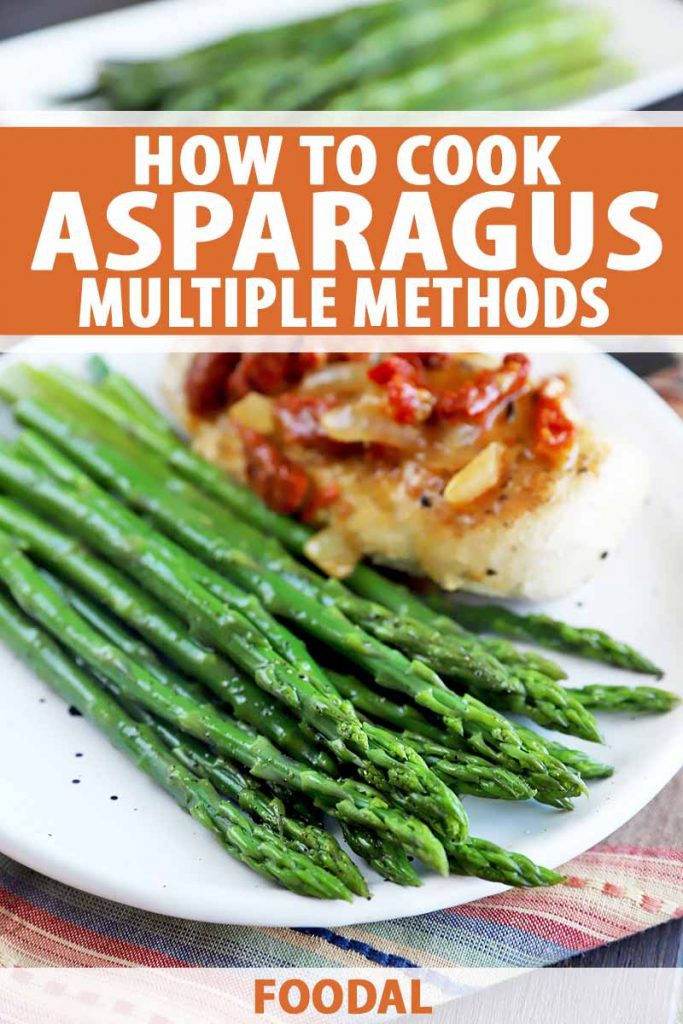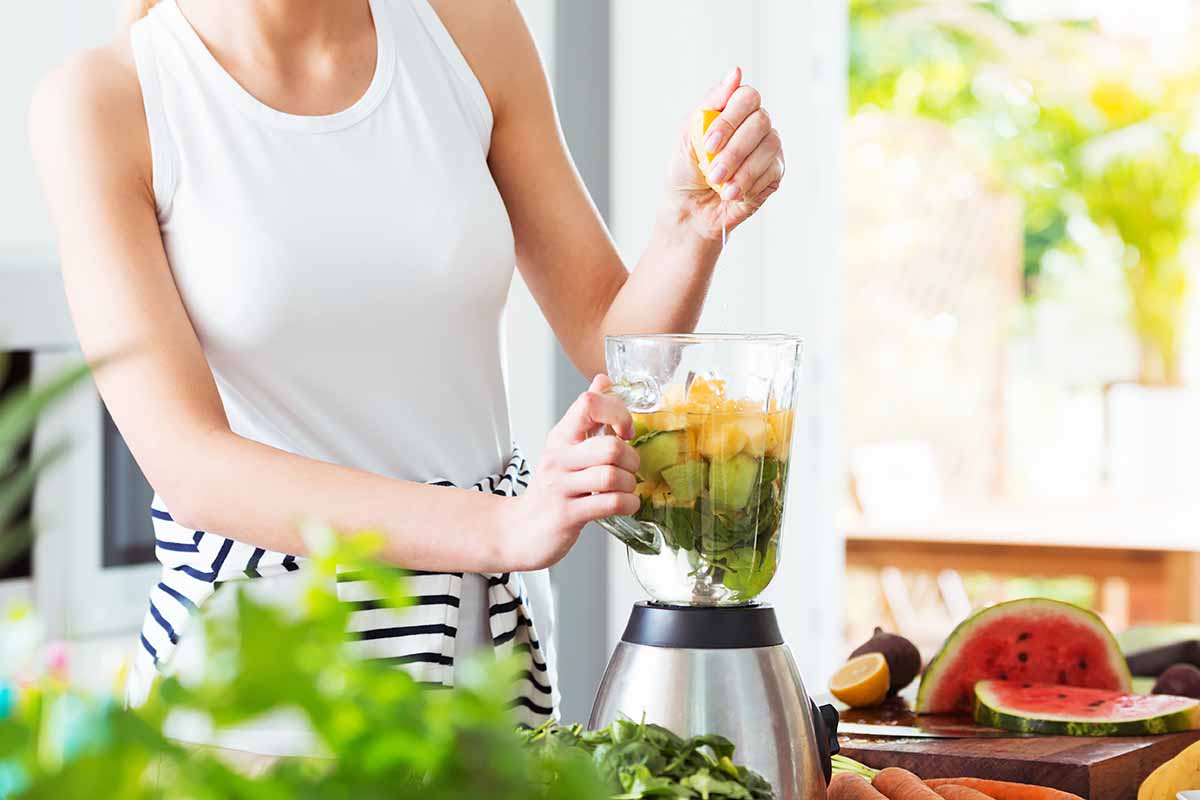Asparagus is my go-to fresh vegetable for spring and summer meals, and I bet it’s one of yours as well. It is extremely versatile, lending itself to multiple cooking methods with tasty results that are all different from each other. And with the proper technique, it is delicious no matter how it’s cooked.

In this guide, we’ll share three ways to cook the vegetable that are easy to master, and essential for your kitchen repertoire – roasting in the oven, steaming, and blanching.
Which one is the best? It’s tough for me to choose a favorite because the asparagus is transformed in different ways with each method of cooking.
When it’s roasted in the oven, the tips turn golden brown, giving the vegetable a little added flavor. When blanched, the spears are bright green and fresh. And when steamed, it comes out beautifully crisp, tender, and delicate.
These aren’t the only ways to cook this veggie! But if I had to pick, they would be my personal top three, and I love the variety that these cooking methods have to offer.

If you already love asparagus, be sure to keep this handy how-to guide close at hand. You can experiment with all three cooking styles and choose your favorite, or rotate between the methods to keep things fresh and enjoy them all as you cook your veggies all season long!
Ready to get started? Here’s what’s to come in this article:
What You’ll Learn
How Do I Buy Asparagus?
This particular vegetable is in season in the US from about February to June, but you can generally purchase it year-round from international sources at your local supermarket.
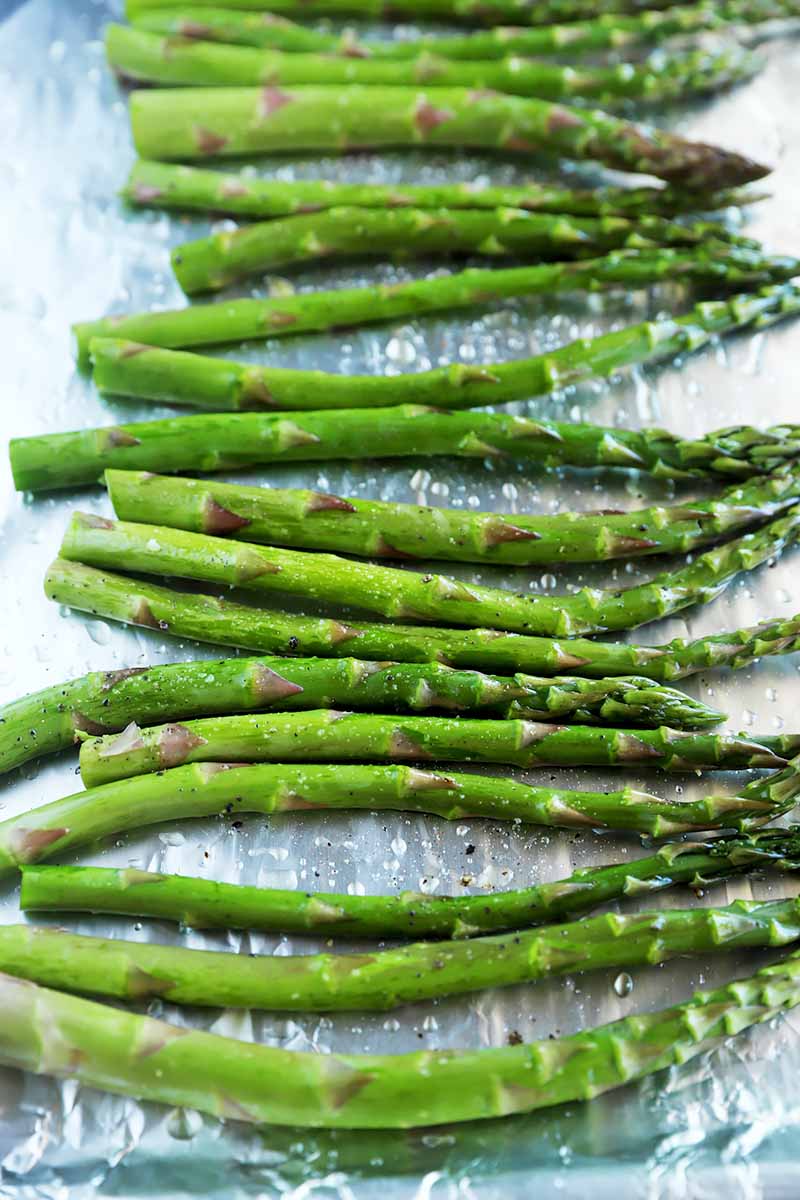
When you are purchasing your veggies, usually by the bunch, the first thing to look at is whether the stalks are stiff. Limp and floppy spears are past their prime.
In addition, the tips of the spears should not be dry. They should be green and moist, an excellent indicator of freshness. If the tips are mushy and turning brown, they are starting to rot and should be tossed.
For more tips on how to select the best fresh vegetables, read our article.
Serving Suggestions
First and foremost, no matter which cooking method you use, be sure to season the vegetables with salt and pepper every single time.
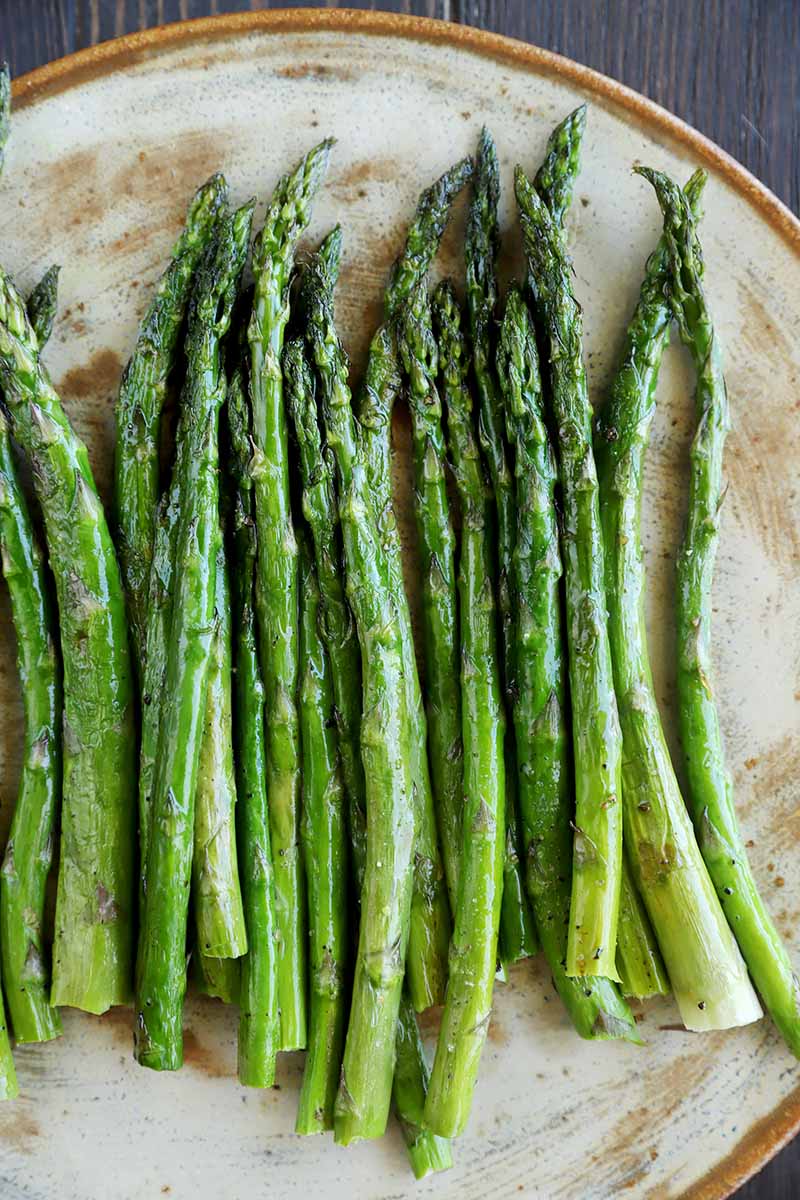
For some this will happen before cooking, and for other methods it will happen after. Regardless, a simple dash of salt and freshly ground black pepper always helps to bring out the natural flavor.
If you want to get a little more creative, here are some of my favorite ways to add additional flavor:
- Add a little garlic powder, melted butter, and lemon juice to the cooked vegetables. You can also add a dash of red pepper flakes for some heat, if you desire.
- Top with homemade hollandaise (particularly delicious over the spears when they’ve been steamed.
- Grate some parmesan cheese over the top and melt under the broiler for a minute or so.
- Chop, add to cooked pasta, sun-dried tomatoes grilled chicken, and stir in some freshly made pesto sauce.
- Include the blanched or roasted spears on top of a frittata with sausage and cheese, or on a crudite platter with your favorite dipping sauce.
- Add some toasted sliced almonds for an amandine dish.
In addition to roasting, blanching, and steaming, it can also be cooked in the microwave, Instant Pot, or air fryer. Don’t be afraid to branch out and try new ways to prepare this family favorite!
And also don’t be afraid to deal with the totally harmless consequence of a smelly bathroom trip, a very common reaction after consuming asparagus!
How to Roast Asparagus in the Oven
Roasting adds delicious flavor, and the vegetables come out crisp-tender and delicious.
Step 1 – Trim Vegetables and Measure Ingredients
To begin, you will need:
- 1 pound fresh asparagus
- 2 tablespoons olive oil
- 1/4 teaspoon salt
- 1/4 teaspoon ground black pepper
Wash and then trim the woody ends off each spear.
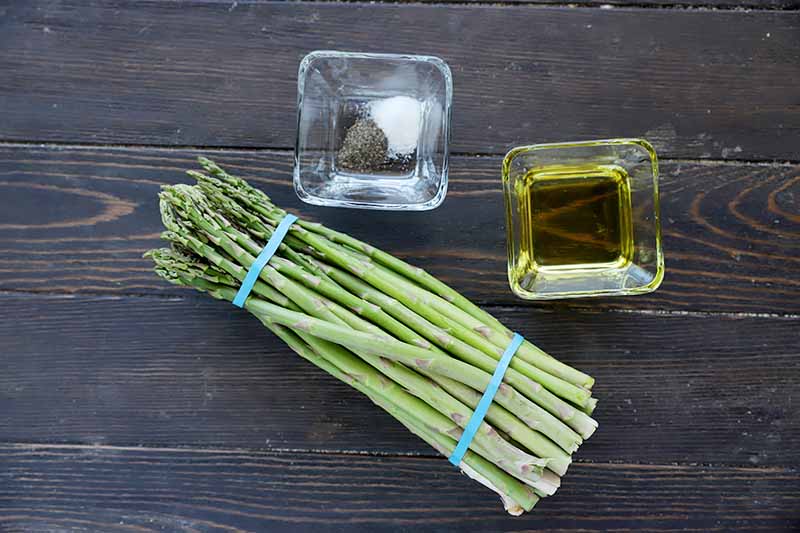
After you’ve measured out the other ingredients, preheat your oven to 400˚F, and line a rimmed baking sheet with aluminum foil.
Step 2 – Prep and Season
Add the prepped vegetables to the prepared baking sheet. Drizzle with olive oil and sprinkle evenly with salt and pepper.
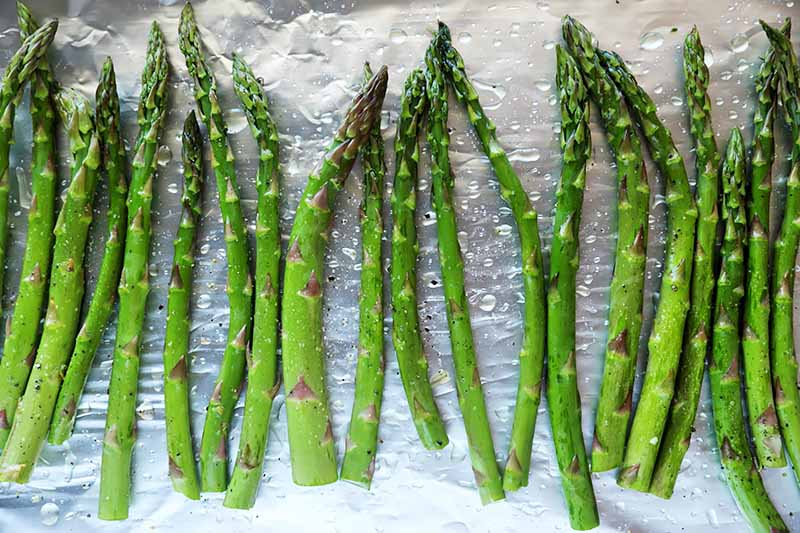
Toss everything together with your hands or tongs, and spread the spears out in a single layer.
Step 3 – Roast
Place the pan in the oven and roast for 12 to 18 minutes, until crisp tender.
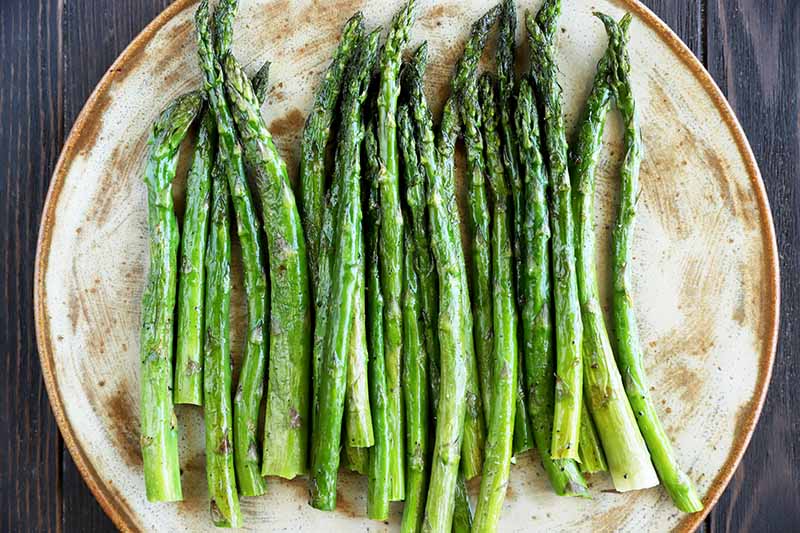
The time required will vary based on the thickness of the spears. For the ones you see here, I roasted them for 13 minutes.
Remove from the oven, and serve as desired.
How to Steam Asparagus
One of the fastest ways to cook this vegetable is to steam it in a pan with a little water. Served with melted butter, I think it’s one of the easiest side dishes you can make.
Step 1 – Trim and Measure
To start, here’s everything you’ll need:
- 1 pound fresh asparagus
- 2 tablespoons unsalted butter, melted
- 1/4 teaspoon salt
- 1/4 teaspoon ground black pepper
Wash the vegetables well. Trim off the woody ends.
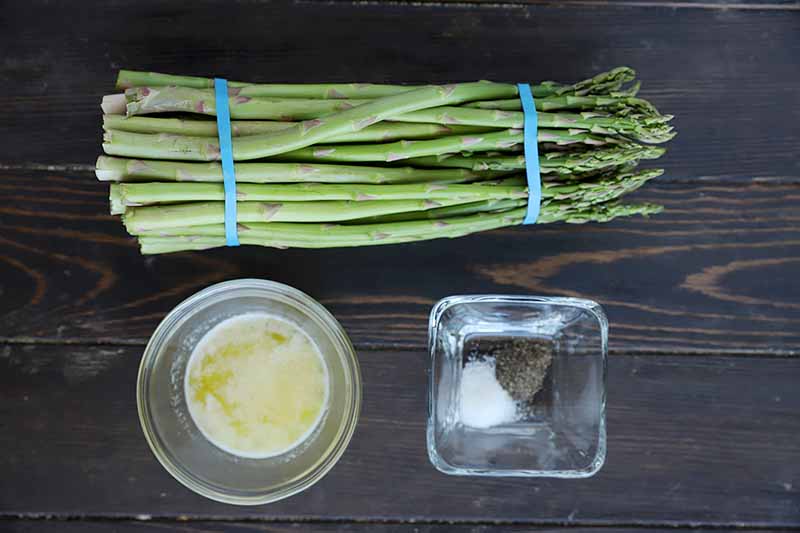
Measure the remaining ingredients as listed.
Step 2 – Steam
Place a large skillet over medium heat and add the prepped vegetable spears in a single layer. Pour in just enough water to cover the bottom of the pan.

For a 12-inch pan, I used 1/3 cup water.
Cover the skillet and steam until fork tender, about 3 to 5 minutes, depending on the thickness of the spears. Check the doneness with a sharp knife to ensure it slides in easily before removing the pan from the heat.
If your spears are very thick, you may need to add a minute or two to the cooking time.
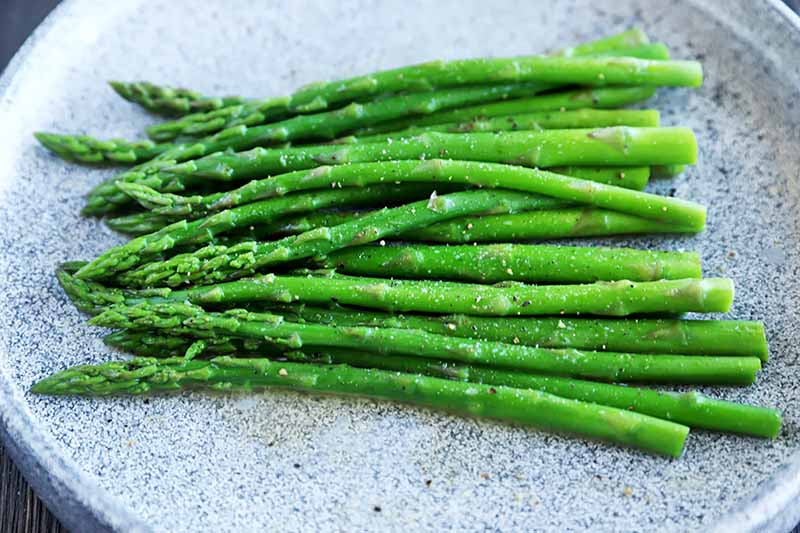
Transfer to a serving platter and toss with butter. Season with salt and pepper.
How to Blanch Asparagus
If you like your vegetables crisp and bright, simply blanch them quickly in some boiling water. Follow up with a shocking ice bath to stop the cooking process.
This is a fantastic way to incorporate these veggies into your lunch meal prep, or to get them ready for use in other recipes.
Step 1 – Trim Ends and Measure Ingredients
For this method, you will need:
- 1 pound fresh asparagus
- 1 tablespoon olive oil
- 1/4 teaspoon salt
- 1/4 teaspoon ground black pepper
- Wash the spears, and then trim them and discard the woody ends.
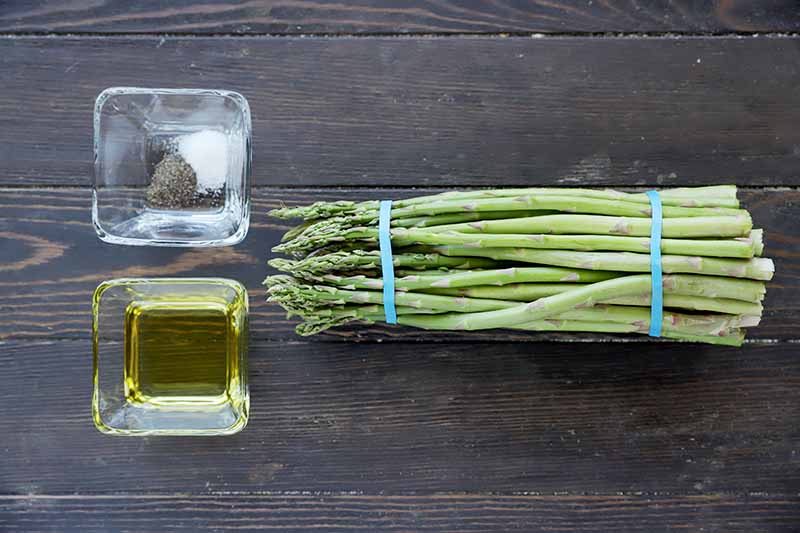
Measure the remaining ingredients as listed.
Step 2 – Blanch
Bring a large pot of salted water to a boil over high heat.

Add the asparagus to the pot of boiling water. Blanch for 2 ½ to 3 minutes, and check for doneness. They should be crisp-tender, vibrant green, and still closer to raw than fully cooked. The blanching time required also depends on the thickness of the spears.
If you prefer to serve them right away, they will continue cooking a bit after they are removed from the water. Drain them immediately in a colander in the sink, and toss in a large mixing bowl with the oil, salt, and pepper, using tongs or your hands. Serve immediately.
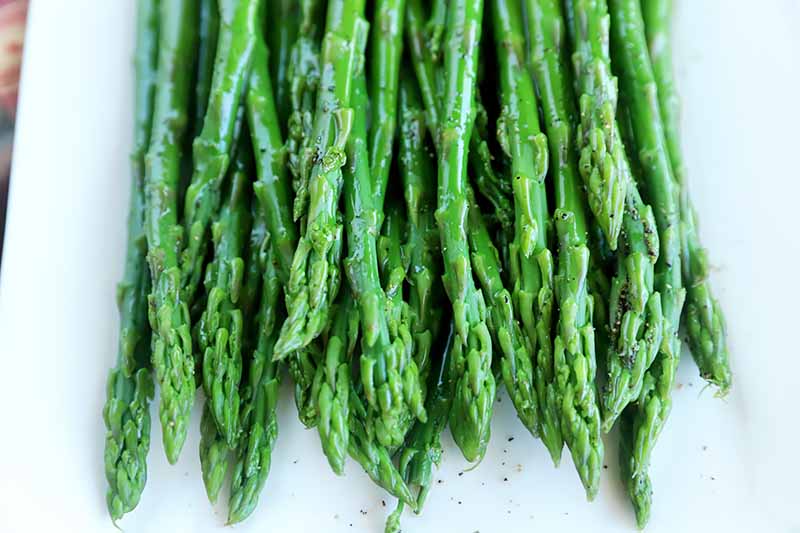
Otherwise, prepare an ice bath by combining ice cubes and cold water in a large bowl. Drain the vegetables, and place in the ice bath for a few minutes, to chill and stop the cooking process. Drain, then season as desired, store in the refrigerator, or prep for use in your favorite recipes, like our fruity asparagus salad served cold with tomatoes, strawberries, and a quick balsamic dressing.
How Will I Know When the Asparagus Is Done?
Determining doneness depends in large part on personal preference, and the thickness of the spears.
Very thin ones require barely any cooking, and crisp-tender steamed or blanched stalks will have a vibrant green color. Thicker stalks will take a little longer.

Roasted, you should look for a deep golden brown color, particularly on the tips. And it’s up to you if you wish to let them go a little longer in the oven to build that caramelization, depending on your preferences for texture and taste.
Feel free to use a knife or fork to pierce a spear as a test for doneness, and adjust the cooking time as needed. You should be able to pierce the thickest part of the stalk without too much force.
If you like your spears cooked until they’re a bit on the softer side rather than crisp tender, you can cook them a little longer.
Hungry for more? Try these side dish recipes from Foodal next to prepare your favorite types of vegetables:
- Collard Greens in the Electric Pressure Cooker
- Corn on the Cob in the Electric Pressure Cooker
- Carrots in an Electric Pressure Cooker
Which cooking method will you try first? Tell us in the comments below!
Photos by Meghan Yager, © Ask the Experts, LLC. ALL RIGHTS RESERVED. See our TOS for more details. With additional writing and editing by Allison Sidhu.
About Meghan Yager
Meghan Yager is a food addict turned food and travel writer with a love for creating uncomplicated, gourmet recipes and devouring anything the world serves up. As the author of the food and travel blog Cake 'n Knife, Meghan focuses on unique foodie experiences from around the world to right at home in your own kitchen.

